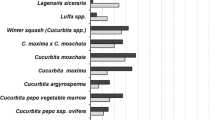Abstract
Root-knot nematodes (Meloidogyne spp.) cause extensive damage to tomato and cucurbit crops in protected cultivation systems. An environmentally benign solution for nematode control is the use of plant resistance that mitigates yield losses and reduces the Meloidogyne population in the soil. A collection of three tomato and six cucumber rootstocks was tested for resistance against eight Meloidogyne incognita populations (with different levels of virulence) in comparison with the susceptible variety Moneymaker and the resistant varieties Phantasia or Oskar. In addition, M. enterolobii was included in these experiments to evaluate the response of the tomato and cucumber plant genotypes. Tests were both conducted in a greenhouse or growth chamber and evaluated after completion of one reproduction cycle. The correlation of plant responses to Meloidogyne populations from the different experiments showed significant relationships for 13 and 20 out of 36 combinations for the parameters gall index and number of egg masses per root system, respectively. In particular, two a-virulent reference populations showed significant positive relationships for both parameters, resulting in the same ranking of tested plant genotypes across test systems. Conversely, plant genotypes showed different responses when inoculated with virulent populations of M. incognita or M. enterolobii. Some of the plant genotypes tested showed potential for use in Meloidogyne spp. management strategies. However, cucumber plant genotypes seemed more suitable than tomato genotypes. Furthermore, some of the tested cucumber rootstocks were less sensitive when challenged with M. enterolobii in pot experiments.

Similar content being viewed by others
References
Brito JA, Stanley JD, Kaur R, Cetintas R, Di Vito M, Thies JA, Dickson DW (2007) Effects of the Mi-1, N and Tabasco genes on infection and reproduction of Meloidogyne mayaguensis on tomato and pepper genotypes. J Nematol 39:327–332
Cortada L, Sorribas FJ, Ornat C, Andrés MF, Verdejo-Lucas S (2008) Response of tomato rootstocks carrying the Mi-resistance gene to populations of Meloidogyne arenaria, M. incognita and M. javanica. Eur J Plant Pathol 124(2):337–343
Cortada L, Sakai H, Verdejo-Lucas S, Mizukubo T (2011) Meloidogyne virulence locus molecular marker for characterization of selected mi-virulent populations of Meloidogyne spp. is correlated with several genera of betaproteobacteria. Phytopathology 101(4):410–415. https://doi.org/10.1094/PHYTO-04-10-0123
Elling AA (2013) Major emerging problems with minor Meloidogyne species. Phytopathology 103(11):1092–1102. https://doi.org/10.1094/PHYTO-01-13-0019-RVW
Freitas VM, Correa VR, Motta FC, Sousa MG, Gomes ACMM, Carneiro MDG, Silva DB, Mattos JK, Nicole M, Carneiro RMDG (2014) Resistant accessions of wild Psidium spp. to Meloidogyne enterolobii and histological characterization of resistance. Plant Pathol 63(4):738–746
Gonçalves LSA, Gomes VM, Robaina RR, Valim RH, Rodrigues R, Aranha FM (2014) Resistance to root-knot nematode (Meloidogyne enterolobii) in Capsicum spp. accessions. Rev Bras de Ciências Agrárias 9:49–52
Huang X, McFiffen M, Kaloshian I (2004) Reproduction of Mi-virulent Meloidogyne incognita isolates on Lycopersicon spp. J Nematol 36:69–75
Hussey RS, Janssen GJW (2002) Root-knot nematodes: Meloidogyne species. In: Starr JL, Cook R, Bridge J (eds) Plant resistance to plant parasitic nematodes. CABI Publishing, Wallingford, pp 43–70
Iberkleid I, Ozalvo R, Feldman L, Elbaz M, Bucki P, Horowitz SB (2014) Responses of tomato genotypes to avirulent and Mi-virulent Meloidogyne javanica isolates occurring in Israel. Phytopathology 104(5):484–496. https://doi.org/10.1094/PHYTO-07-13-0181-R
Kiewnick S, Karssen G, Brito JA, Oggenfuss M, Frey JE (2008) Occurrence of Meloidogyne enterolobii in Switzerland. Plant Dis 115:134
Kiewnick S, Dessimoz M, Franck L (2009) Effects of the Mi-1 and the N root-knot nematode-resistance gene on infection and reproduction of Meloidogyne enterolobii on tomato and pepper cultivars. J Nematol 41(2):134–139
López-Gómez M, Flor-Peregrín E, Talavera M, Verdejo-Lucas S (2015) Suitability of zucchini and cucumber genotypes to populations of Meloidogyne arenaria, M. incognita, and M. javanica. J Nematol 47(1):79–85
Robertson L, Diez-Rojo MA, Lopez-Perez J, Buena AP, Escuer M, Cepero JL, Martinez C, Bello A (2009) New host races of Meloidogyne arenaria, M. incognita, and M. javanica from horticultural regions of Spain. Plant Dis 93:180–184
Seid A, Fininsa C, Mekete T, Decraemer W, Wesemael WML (2015) Tomato (Solanum lycopersicum) and root-knot nematodes (Meloidogyne spp.)—a century-old battle. Nematology 17(9):995–1009
Talavera M, Verdejo-Lucas S, Ornat C, Torres J, Vela MD, Macias FJ, Cortada L, Arais DJ, Valero J, Sorribas FJ (2009) Crop rotations with Mi gene resistant and susceptible tomato cultivars for management of root-knot nematodes in plastic houses. Crop Prot 28:662–667
Tzortzakakis EA, Conceicao I, Dias AM, Simoglou KB, Abrantes I (2014) Occurrence of a new resistant breaking pathotype of Meloidogyne incognita on tomato in Greece. J Plant Dis Prot 121(4):184–186
Verdejo-Lucas S, Cortada L, Sorribas FJ, Ornat C (2009) Selection of virulent populations of Meloidogyne javanica by repeated cultivation of Mi resistance gene tomato rootstocks under field conditions. Plant Pathol 58(5):990–998. https://doi.org/10.1111/j.1365-3059.2009.02089.x
Zeck WM (1971) A rating scheme for field evaluation of root-knot nematode infestations. Pflanzenschutznachrichten Bayer 24:141–144
Acknowledgements
The seeds were kindly provided by the breeding companies de Ruiter, Rijk Zwaan, S&G Syngenta and Hild/Nunhems. Ulrike Schmidt (Beratungsdienst Reichenau e.V., Germany) is acknowledged for providing Meloidogyne populations. Stefanie Wolf is acknowledged for technical assistance with greenhouse experiments.
Author information
Authors and Affiliations
Corresponding author
Ethics declarations
Conflict of interest
Authors declare that they have no conflict of interest.
Rights and permissions
About this article
Cite this article
Hallmann, J., Kiewnick, S. Virulence of Meloidogyne incognita populations and Meloidogyne enterolobii on resistant cucurbitaceous and solanaceous plant genotypes. J Plant Dis Prot 125, 415–424 (2018). https://doi.org/10.1007/s41348-018-0165-5
Received:
Accepted:
Published:
Issue Date:
DOI: https://doi.org/10.1007/s41348-018-0165-5




